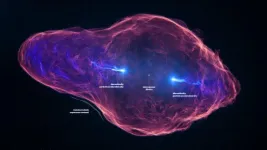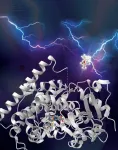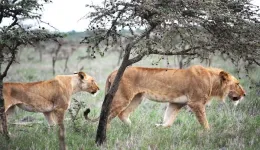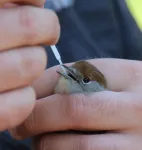(Press-News.org) Because viruses have to hijack someone else’s cell to replicate, they’ve gotten very good at it—inventing all sorts of tricks.
A new study from two University of Chicago scientists has revealed how HIV squirms its way into the nucleus as it invades a cell.
According to their models, the HIV capsid, which is cone-shaped, points its smaller end into the pores of the nucleus and then ratchets itself in. Once the pore is open enough, the capsid is elastic enough to squeeze through. Importantly, the scientists said, both the structural flexibility of the capsid and the pore itself play a role in the infiltration process.
The finding, created by a simulation of thousands of proteins interacting, will point the way to a better understanding of HIV as well as suggest new targets for therapeutic drugs. “For example, you could try to make the HIV capsid less elastic, which our data suggests would hamper its ability to get inside the nucleus,” said Arpa Hudait, a research scientist at UChicago and first author of the paper.
The study also provides the most extensive simulation yet of the nuclear pore itself, which is important in many biological processes.
Capsid vs. cell
Hudait is a member of the laboratory of Gregory Voth, the Haig P. Papazian Distinguished Service Professor of Chemistry, which specializes in simulations to unravel the complex biological processes that occur as viruses attack a cell.
In this case, Voth and Hudait focused on what’s known as the HIV capsid—the capsule containing HIV’s genetic material, which enters a host cell’s nucleus and forces the cell to make copies of the key HIV components.
The capsid is a complex piece of machinery, made of more than a thousand proteins assembled into a cone-like shape, with a smaller and larger end. To get into the host cell’s nucleus, it must sneak in. But scientists didn’t know exactly how this happens. “This part has been a mystery for years,” said Voth, the senior author on the paper. “For a long time, no one was sure whether the capsid broke apart before entering the pore or afterwards, for example.”
Recent imaging studies had suggested the capsid stays intact wriggling through the nuclear pore complex. This is essentially the mail slot where the nucleus sends and receives deliveries.
“The pore complex is an incredible piece of machinery; it can’t let just anything into the nucleus of your cell, or you’d be in real trouble, but it’s got to let quite a bit of stuff in. And somehow, the HIV capsid has figured out how to sneak in,” Voth said. “The problem is, we can’t watch it live. You have to go to heroic experimental efforts to even get a single, moment-in-time snapshot.”
To fill in the gaps, Hudait built a painstaking computer simulation of both the HIV capsid and the nuclear pore complex—accounting for thousands of proteins working together.
Running the simulations, the scientists saw that it was much easier for the capsid to get into the pore by wedging its smallest end in first, and then gradually ratcheting itself in. “It doesn’t need active work to do it, it’s just physics—what we call an electrostatic ratchet,” said Voth. “It’s kind of like if you’ve ever had a seatbelt tighten up on you, where it just keeps getting tighter and tighter.”
They also found both the pore and the capsid deform as it goes. Interestingly, the lattice of molecules that make up the capsid structure develops little regions of less order to accommodate the stress of the pressure. “It’s not like a solid compressing or expanding, as one might have expected,” said Hudait.
The finding may help explain why capsids are cone-shaped, rather than a shape like a cylinder, which might seem at first easier to slip through a pore.
The scientists said that each detail in HIV’s journey through the body is an opportunity to find vulnerabilities where drugs could be developed to target. It’s also a look in the broader sense at a fundamental aspect of biology.
“I think this modeling also gives us a new way to understand how many things get into the nucleus, not just HIV,” said Voth.
The simulations were performed at the Texas Advanced Computing Center at the University of Texas at Austin and the Research Computing Center at UChicago.
END
Simulations show how HIV sneaks into the nucleus of the cell
UChicago chemists assemble massive model of the nuclear pore complex and HIV-1 virus capsid
2024-01-25
ELSE PRESS RELEASES FROM THIS DATE:
White House rule dramatically deregulated wetlands, streams and drinking water
2024-01-25
The 1972 Clean Water Act protects the "waters of the United States" but does not precisely define which streams and wetlands this phrase covers, leaving it to presidential administrations, regulators, and courts to decide. As a result, the exact coverage of Clean Water Act rules is difficult to estimate.
New research led by a team at the University of California, Berkeley, used machine learning to more accurately predict which waterways are protected by the Act. The analysis found that a 2020 Trump administration rule removed Clean Water Act ...
How an ant invasion led to lions eating fewer zebra in a Kenyan ecosystem
2024-01-25
The invasion of non-native species can sometimes lead to large and unexpected ecosystem shifts, as Douglas Kamaru and colleagues demonstrate in a unique, careful study that traces the links between big-headed ants, acacia trees, elephants, lions, zebras, and buffalo at a Kenyan conservancy. The invasive big-headed ant species disrupted a mutualism between native ants and the region’s thorny acacia trees, in which the native ants protected the trees from grazers in exchange for a place to live. Through a combination of observations, experimental plots, and animal tracking at Ol Pejeta Conservancy, Kamaru et al. followed the ecosystem chain reaction prompted by this disruption. ...
Total organic carbon concentrations measured over Canadian oil sands reveal huge underestimate of emissions
2024-01-25
New measurements of total gaseous organic carbon concentrations in the air over the Athabasca oil sands in Canada suggest that traditional methods of estimating this pollution can severely underestimate emissions, according to an analysis by Megan He and colleagues. Using aircraft-based measurements, He et al. conclude that the total gaseous organic carbon emissions from oil sands operations exceed industry-reported values by 1900% to over 6300% across the studied facilities. “Measured facility-wide emissions represented approximately 1% of extracted petroleum, resulting in total organic ...
Machine learning model identifies waters protected under different interpretations of the U.S. Clean Water Act
2024-01-25
The U.S. Clean Water Act is a critically important part of federal water quality regulation, but the act does not define the exact waters that fall under its jurisdiction. Now, Simon Greenhill and colleagues have developed a machine learning model that helps to clarify which waters are protected from pollution under the United States’ Clean Water Act, and how recent rule changes affect protection. The model demonstrates that the waters protected under the act differ substantially depending on whether the act’s regulations follow a 2006 U.S. Supreme Court ruling or a 2020 White House rule. Under the 2006 Rapanos Supreme Court ruling, the model suggests that the Clean ...
Gamma ray observations of a microquasar demonstrate electron shock acceleration
2024-01-25
Observations of gamma rays, emitted by relativistic jets in a microquasar system, demonstrate the acceleration of electrons by a shock front, reports a new study. The microquasar SS 433 is a binary system made up of a compact object, probably a black hole, and a supergiant star. The black hole pulls material off the star and ejects plasma jets, which move at close to the speed of light. The High Energy Stereoscopic System (H.E.S.S.) is an array of five telescopes in Namibia that observe gamma rays. The H.E.S.S. ...
Astrophysical jet caught in a “speed trap”
2024-01-25
The science fiction author Arthur C. Clarke selected his own seven wonders of the world in a BBC television series in 1997. The only astronomical object he included was SS 433. It had attracted attention already in the late 1970s due to its X-ray emission and was later discovered to be at the center of a gas nebula that is dubbed the manatee nebula due to its unique shape resembling these aquatic mammals.
SS 433 is a binary star system in which a black hole, with a mass approximately ten times that of the Sun, and a star, with a similar mass but occupying a much larger volume, orbit each other with ...
Experts call for major shift in international decision-making to tackle ‘devastating’ impact of urban expansion and avoid ‘planetary catastrophe’
2024-01-25
Leading scientists are today calling for an urgent step change in global governance to save the future of worldwide cities and the planet at large.
Cities are growing at an unprecedented rate, putting overwhelming pressures on exploited land, scarce resources, and fragile ecosystems. The bold proposals, led by experts from the Universities of Bristol, Oxford and Yale, are set out in a Science journal article, proposing a new global advisory system to address the alarming impacts of urban expansion. This system would fulfil a similar function as the Intergovernmental ...
Teaching nature to break man-made chemical bonds
2024-01-25
For the first time, scientists have engineered an enzyme that can break stubborn man-made bonds between silicon and carbon that exist in widely used chemicals known as siloxanes, or silicones. The discovery is a first step toward rendering the chemicals, which can linger in the environment, biodegradable.
"Nature is an amazing chemist, and her repertoire now includes breaking bonds in siloxanes previously thought to evade attack by living organisms," says Frances Arnold, the Linus Pauling Professor of Chemical Engineering, Bioengineering and Biochemistry at Caltech and winner of the 2018 Nobel ...
Tiny ant species disrupts lion’s hunting behavior
2024-01-25
What makes the little old ant think he can disrupt the life of an African lion?
Researchers say it’s more than just high hopes.
In a study published today in the journal Science, a team of scientists reports that a tiny and seemingly innocuous invasive ant species is changing tree cover in an East African wildlife area, making it harder for lions, the world’s most iconic predator, to hunt its preferred prey, zebra.
“These tiny invaders are cryptically pulling on the ties that bind an African ecosystem together, determining who is eaten and ...
West Nile virus emergence and spread in Europe found to be positively associated with agricultural activities
2024-01-25
The spread of West Nile virus in Europe is strongly linked to agricultural activities, urbanization, and bird migration, according to a modelling study published January 25, 2024 in the open-access journal PLOS Pathogens by Lu Lu from the University of Edinburgh, UK, and collaborators belonging to a large European collaborative consortium under the VEO (Versatile Emerging infectious disease Observatory) project.
West Nile virus outbreaks have occurred in birds (the natural hosts and reservoirs for the virus), livestock, and ...
LAST 30 PRESS RELEASES:
Researchers find promising new way to boost the immune response to cancer
Coffee as a staining agent substitute in electron microscopy
Revealing the diversity of olfactory receptors in hagfish and its implications for early vertebrate evolution
Development of an ultrasonic sensor capable of cuffless, non-invasive blood pressure measurement
Longer treatment with medications for opioid use disorder is associated with greater probability of survival
Strategy over morality can help conservation campaigns reduce ivory demand, research shows
Rising temperatures reshape microbial carbon cycling during animal carcass decomposition in water
Achieving ultra-low-power explosive jumps via locust bio-hybrid muscle actuators
Plant-derived phenolic acids revive the power of tetracycline against drug-resistant bacteria
Cooperation: A costly affair in bacterial social behaviour?
Viruses in wastewater: Silent drivers of pollution removal and antibiotic resistance
Sub-iethal water disinfection may accelerate the spread of antibiotic resistance
Three in four new Australian moms struggle with body image
Post-stroke injection protects the brain in preclinical study
Cardiovascular risk score predicts multiple eye diseases
Health: estimated one in ten British adults used or interested in GLP-1 medications for weight loss
Exercise to treat depression yields similar results to therapy
Whooping cough vaccination for pregnant women strengthens babies’ immune system
Dramatic decline in new cases of orphanhood in Uganda driven by HIV treatment and prevention programs
Stopping weight loss drugs linked to weight regain and reversal of heart health markers
Higher intake of food preservatives linked to increased cancer risk
Mass General Brigham–developed cholera vaccine completes phase 1 trial
First experimental validation of a “150-year-old chemical common sense” direct visualization of the molecular structural changes in the ultrafast anthracene [4+4] photocycloaddition reaction
Lack of support for people on weight loss drugs leaves them vulnerable to nutritional deficiencies, say experts
Dogs’ dinners can have greater climate impact than owners’
Are you ready to swap salmon for sprats and sardines?
1.6 million UK adults used weight loss drugs in past year
American College of Cardiology comments on new dietary guidelines for Americans
American Society of Gene & Cell Therapy and Orphan Therapeutics Accelerator partner to advance and commercialize promising rare disease treatments
One in 14 patients having day case surgery have new or worse chronic pain 3 months after their operation
[Press-News.org] Simulations show how HIV sneaks into the nucleus of the cellUChicago chemists assemble massive model of the nuclear pore complex and HIV-1 virus capsid



